Ch7:Address Resolution Protocol(ARP)
ARP & RARP
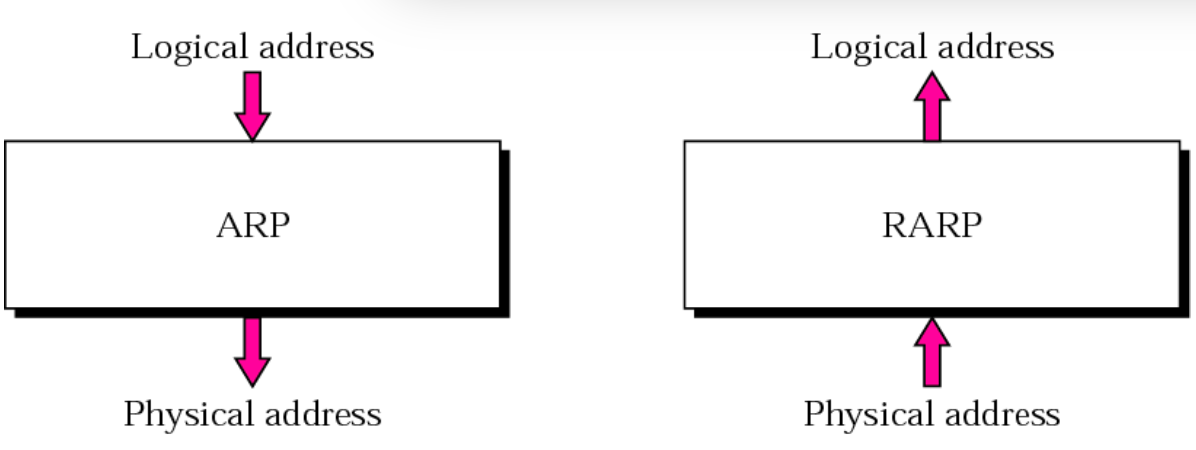
A is an Internet address. It`s jurisdiction is universal, a logical address is unique universally.
A is a local address. It`s jurisdiction is a local network, it should be unique locally.
The maps a logical address to a physical address.

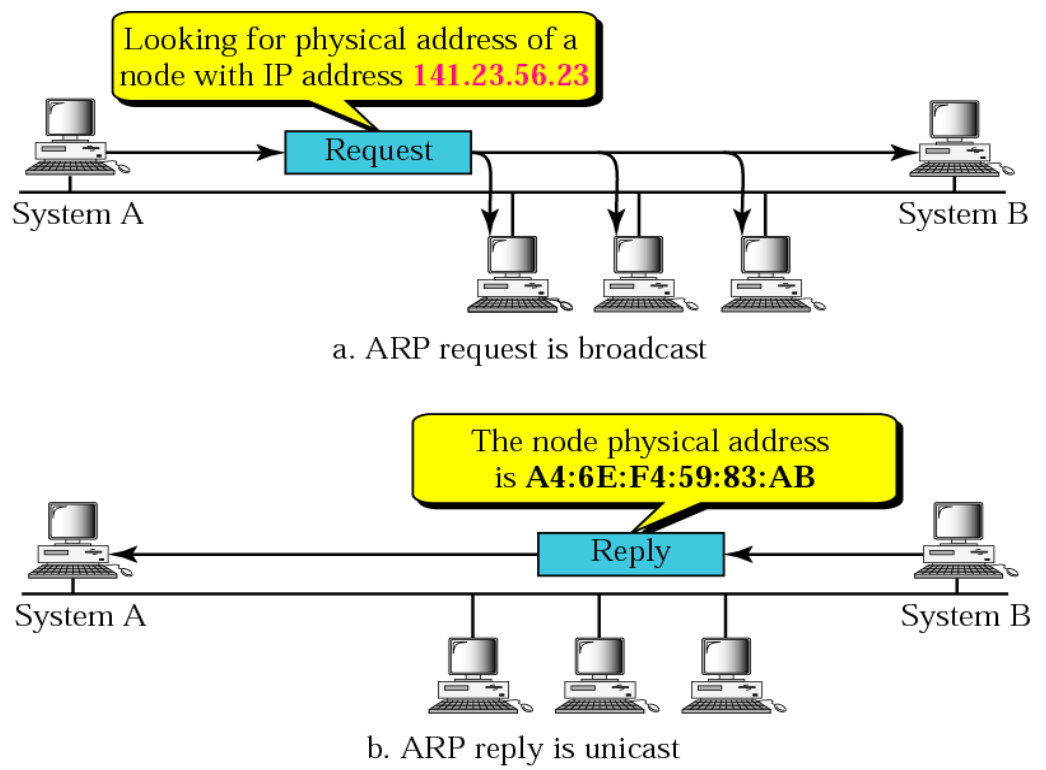
ARP request is broadcast and ARP reply is unicast
The Sender asks the receiver to announce its physical address when needed. ARP is designed to this purpose. Anytime, a host(router) needs to find the physical address of another host(router) on its network, it sends an and the query packet is broadcast over the network.
Host will ignore the ARP request, if the IP address is not the host. Otherwise the host will reply to the sender.
Every host(router) on the network receives and processes the ARP query packet. But only the intended recipient recognizes its IP address and sends back an .
Formate of an ARP Packet
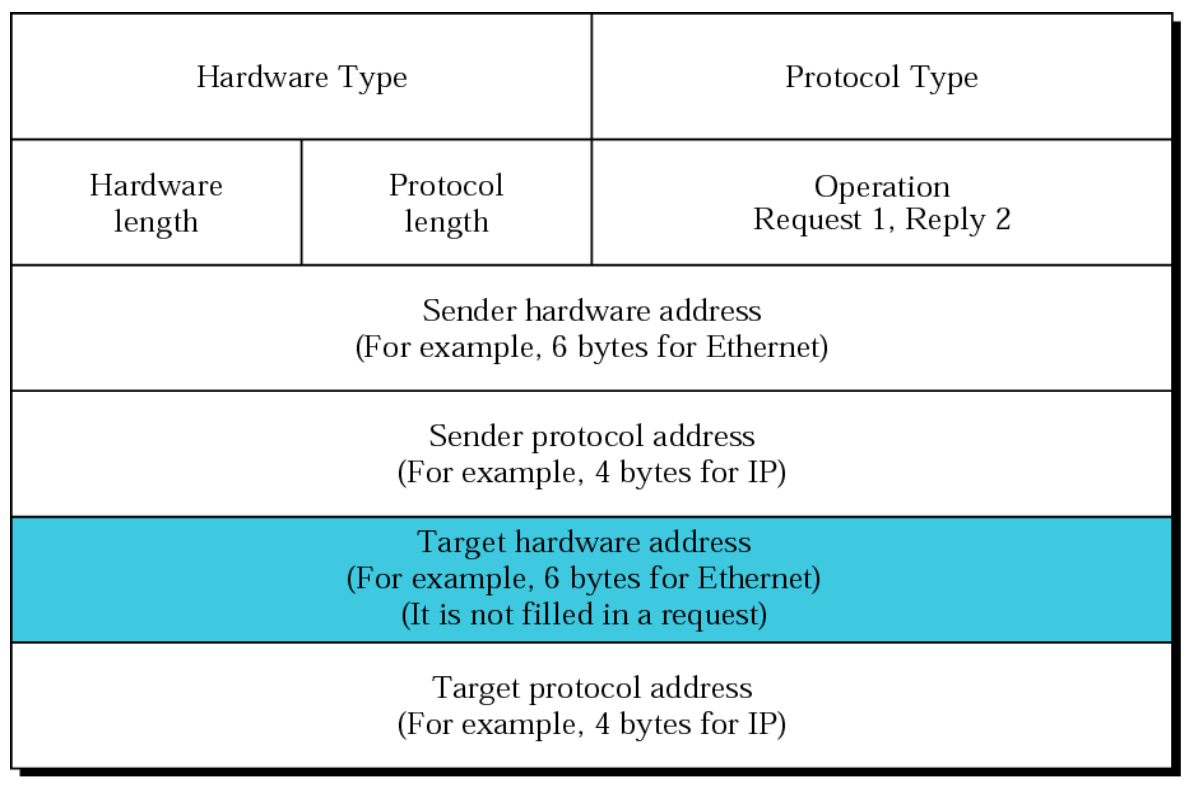
-
Hardware type: This is a 16-bit field defining the type of the network on which ARP is running.
-
Protocol Type: This is a 16-bit field defining the protocol.
-
Hardware length: This is an 8-bit field defining the length of the physical address in bytes.(6 bytes for Ethernet)
-
Protocol length: This is an 8-bit field defining the length of the logical address in bytes.(4 bytes for IP address)
-
Operation: This is a 16-bit field defining the the type of the packet.(why 16?)
-
Sender hardware address: This is a variable-length field defining the physical address of the sender.
-
Sender protocol address: This is a variable-length field defining the protocol address of the sender.
-
Target hardware address: This is a variable-length field defining the physical address of the target. For ARP request is field is all 0s, because the sender foes not know the physical address of the target.
-
Target protocol address: This is a variable-length field defining the protocol address of the target.
Encapsulation of ARP packet
 A ARP packet is encapsulated into a datalink frame.
A ARP packet is encapsulated into a datalink frame.
The ARP process
- The sender knows the IP address of the target.
- IP asks ARP to create an ARP request packet.
- The packet is encapsulated in a frame using the as the destination address.
- All machines except the one targeted drop the packet.
- The target machine replies with an ARP Reply Packet containing its physical address. This packet is unicast.
- The sender receives the reply packet.
- The IP datagram is now encapsulated in a frame and is unicast to the target machine.
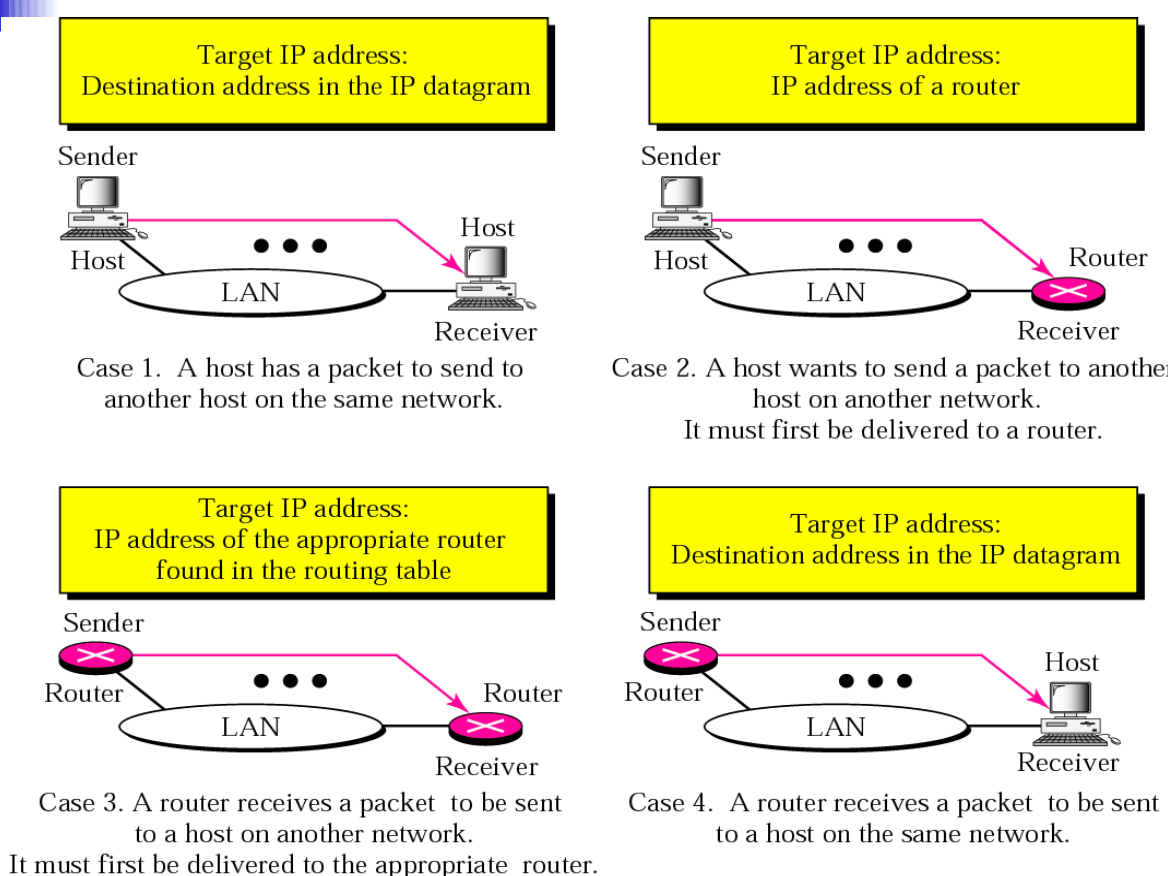
Four cases using ARP packet
 physical broadcast address is OxFFFFFFFF
physical broadcast address is OxFFFFFFFF
In the ARP request, as the sender do not know the physical address of the receiver, it will use the physical broadcast address to send the ARP request to all hosts in the Ethernet.
PS: CRC, Preamble and SFD are part of the Ethernet frame.
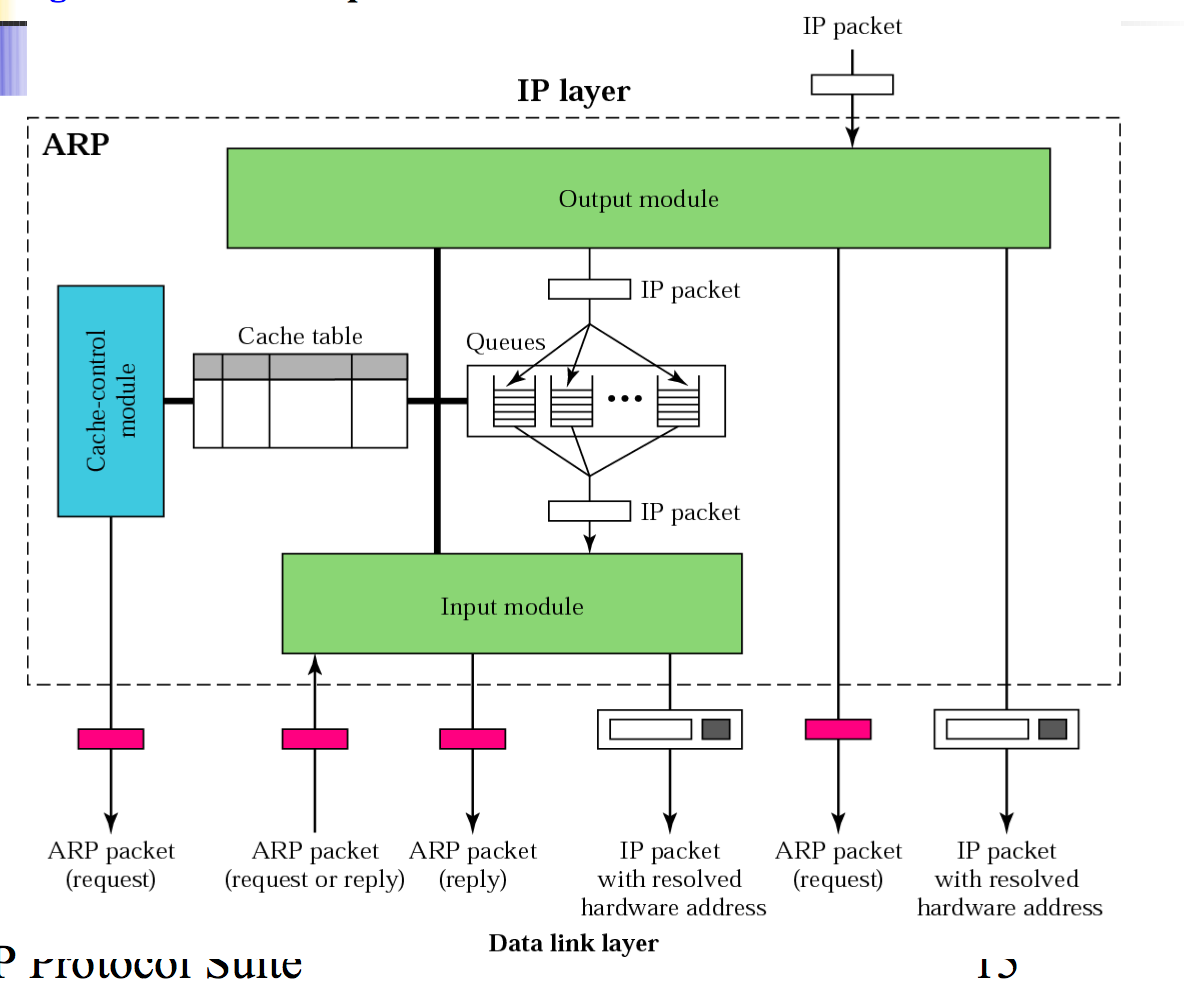 The ARP packet involves the following components:
The ARP packet involves the following components:
- cache table
- cache-control module
- Queues
- Output module
- Input module
It is inefficient to use ARP protocol for each datagram destined to the same host/router. When a host/router receives the corresponding physical address for an IP datagram, the address can be saved in a . These addresses can be used for the datagrams destined to the same receiver within the next few minutes.
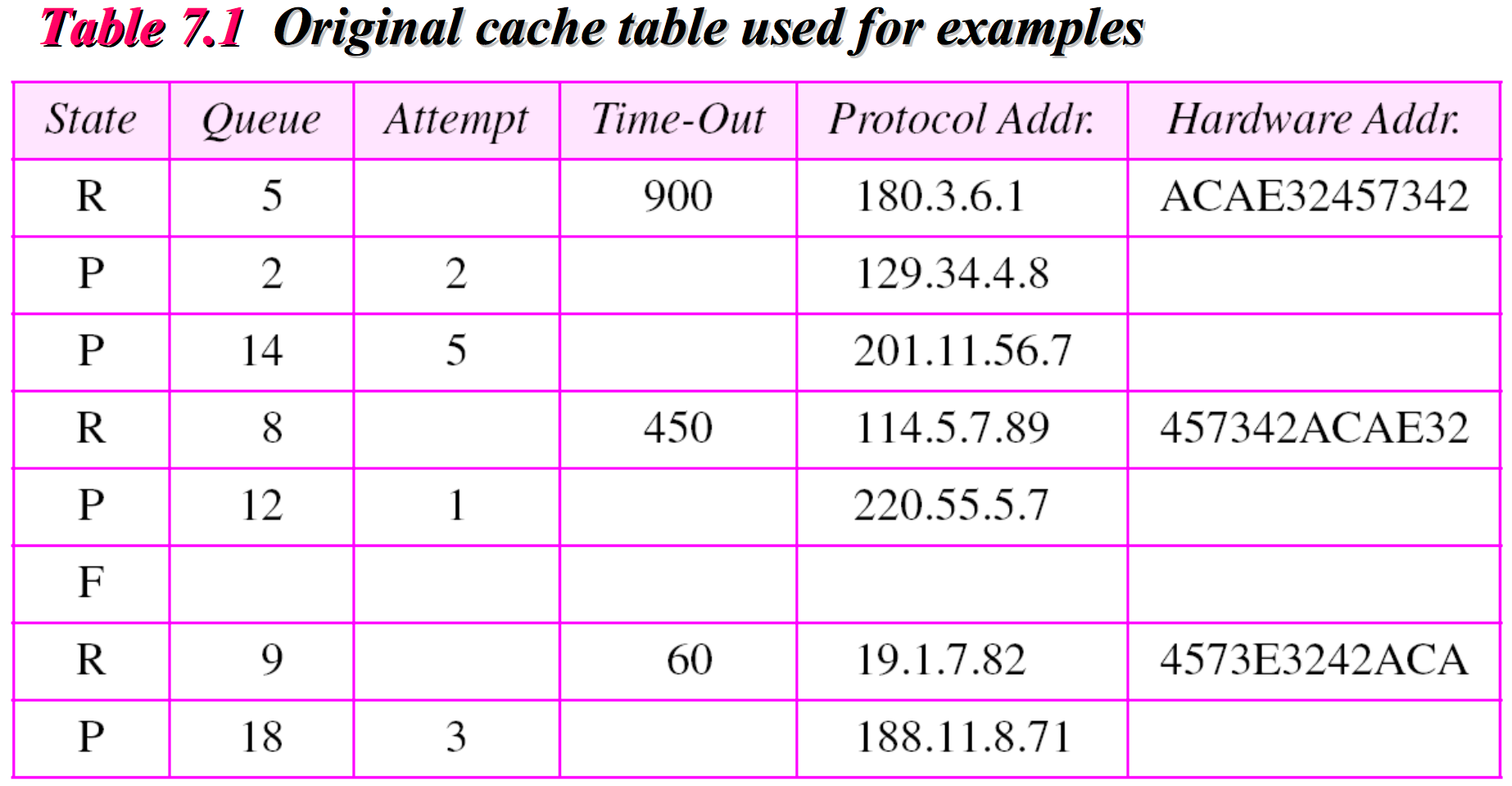 The cache table is implemented as an array of entries: each entry contains the following fields:
State:
The cache table is implemented as an array of entries: each entry contains the following fields:
State:
P: “pending” state means a request for this entry has been sent, but the reply has not been received yet;
R: “resolved” state means that the entry is complete;
F: “free” state means that the time-to-live for this entry has expired. The space can be used for a new entry;
Queue number: ARP uses numbered queues to enqueue the packets waiting for the address resolution packets for the same destination are enqueue in the same queue.
Attempt: This column shows the number of times an ARP request is send out for this entry.
Time-Out: This column shows the lifetime of an entry in seconds.
Protocol address: This column shows the target IP address.
Hardware address: This column shows the destination hardware address. It remains empty until resolved by ARP reply.
Queues: The ARP packet maintains A set of queues, one for each destination to hold the IP packets while ARP tries to resolve the hardware address.
Output Module:
- Sleep until an IP packet is received from IP software.
- Check the cache table for an entry corresponding to the destination of this packet.
- If found:
if the state is "resolved": a. extract the value of the hardware address from the entry; b. send the packet and the hardware address to the datalink layer; c. return; if the state is "pending": a. Enqueue the packet to the corresponding queue. b. return - If not found:
a. Create a entry with state set to "pending", and "attempts" set to 1. b. Create a new queue. c. Enqueue the packet. d. Send an ARP request. - Return;
Input Module:
- Sleeps until an ARP packet(request or reply) arrives.
- Check the cash table to find an entry corresponding to this ARP packet
- If found:
a. Update the entry. b. If the state is "pending": Dequeue the packet; Send the packet and the hardware address to the datalink layer. - If not found:
a. Create an entry b. Add the entry to the table. - If the packet is a request, send the ARP reply.
- Return;
The is responsible for maintaining the cache table. If periodically checks the cache table entry by entry.
Cache control module
- Sleep until the periodic time(T) expires.
- For every entry in the cache table:
If the state is "free", continue; If the state is "pending": a. Increase the value of attempts by 1. b. If the number of attempts greater than the Maximum. Change the state to "free", delete everything else, destroy the corresponding queue, and drop the packets in it. Else send an ARP request. If the state is "resolved": a. Decrease the value of timeout by the value of elapsed time(经过的时间). b. If time-out less than or equal to 0. Change the state to "free", Destroy the corresponding queue and drop the packets in it.
Comments